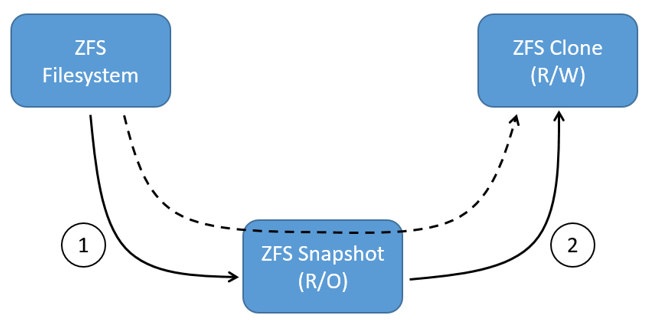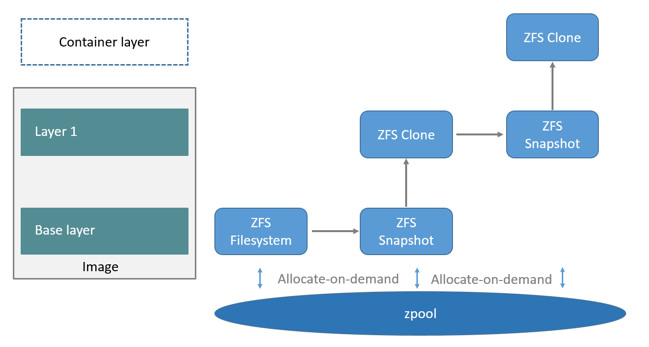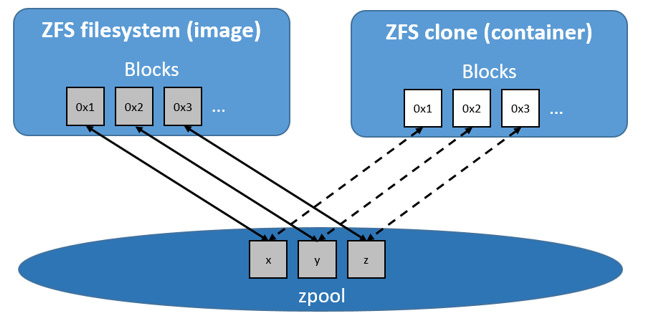github.com/noxiouz/docker@v0.7.3-0.20160629055221-3d231c78e8c5/docs/userguide/storagedriver/zfs-driver.md (about) 1 <!--[metadata]> 2 +++ 3 title = "ZFS storage in practice" 4 description = "Learn how to optimize your use of ZFS driver." 5 keywords = ["container, storage, driver, ZFS "] 6 [menu.main] 7 parent = "engine_driver" 8 +++ 9 <![end-metadata]--> 10 11 # Docker and ZFS in practice 12 13 ZFS is a next generation filesystem that supports many advanced storage 14 technologies such as volume management, snapshots, checksumming, compression 15 and deduplication, replication and more. 16 17 It was created by Sun Microsystems (now Oracle Corporation) and is open sourced 18 under the CDDL license. Due to licensing incompatibilities between the CDDL 19 and GPL, ZFS cannot be shipped as part of the mainline Linux kernel. However, 20 the ZFS On Linux (ZoL) project provides an out-of-tree kernel module and 21 userspace tools which can be installed separately. 22 23 The ZFS on Linux (ZoL) port is healthy and maturing. However, at this point in 24 time it is not recommended to use the `zfs` Docker storage driver for 25 production use unless you have substantial experience with ZFS on Linux. 26 27 > **Note:** There is also a FUSE implementation of ZFS on the Linux platform. 28 > This should work with Docker but is not recommended. The native ZFS driver 29 > (ZoL) is more tested, more performant, and is more widely used. The remainder 30 > of this document will relate to the native ZoL port. 31 32 33 ## Image layering and sharing with ZFS 34 35 The Docker `zfs` storage driver makes extensive use of three ZFS datasets: 36 37 - filesystems 38 - snapshots 39 - clones 40 41 ZFS filesystems are thinly provisioned and have space allocated to them from a 42 ZFS pool (zpool) via allocate on demand operations. Snapshots and clones are 43 space-efficient point-in-time copies of ZFS filesystems. Snapshots are 44 read-only. Clones are read-write. Clones can only be created from snapshots. 45 This simple relationship is shown in the diagram below. 46 47  48 49 The solid line in the diagram shows the process flow for creating a clone. Step 50 1 creates a snapshot of the filesystem, and step two creates the clone from 51 the snapshot. The dashed line shows the relationship between the clone and the 52 filesystem, via the snapshot. All three ZFS datasets draw space form the same 53 underlying zpool. 54 55 On Docker hosts using the `zfs` storage driver, the base layer of an image is a 56 ZFS filesystem. Each child layer is a ZFS clone based on a ZFS snapshot of the 57 layer below it. A container is a ZFS clone based on a ZFS Snapshot of the top 58 layer of the image it's created from. All ZFS datasets draw their space from a 59 common zpool. The diagram below shows how this is put together with a running 60 container based on a two-layer image. 61 62  63 64 The following process explains how images are layered and containers created. 65 The process is based on the diagram above. 66 67 1. The base layer of the image exists on the Docker host as a ZFS filesystem. 68 69 This filesystem consumes space from the zpool used to create the Docker 70 host's local storage area at `/var/lib/docker`. 71 72 2. Additional image layers are clones of the dataset hosting the image layer 73 directly below it. 74 75 In the diagram, "Layer 1" is added by making a ZFS snapshot of the base 76 layer and then creating a clone from that snapshot. The clone is writable and 77 consumes space on-demand from the zpool. The snapshot is read-only, maintaining 78 the base layer as an immutable object. 79 80 3. When the container is launched, a read-write layer is added above the image. 81 82 In the diagram above, the container's read-write layer is created by making 83 a snapshot of the top layer of the image (Layer 1) and creating a clone from 84 that snapshot. 85 86 As changes are made to the container, space is allocated to it from the 87 zpool via allocate-on-demand operations. By default, ZFS will allocate space in 88 blocks of 128K. 89 90 This process of creating child layers and containers from *read-only* snapshots 91 allows images to be maintained as immutable objects. 92 93 ## Container reads and writes with ZFS 94 95 Container reads with the `zfs` storage driver are very simple. A newly launched 96 container is based on a ZFS clone. This clone initially shares all of its data 97 with the dataset it was created from. This means that read operations with the 98 `zfs` storage driver are fast – even if the data being read was note 99 copied into the container yet. This sharing of data blocks is shown in the 100 diagram below. 101 102  103 104 Writing new data to a container is accomplished via an allocate-on-demand 105 operation. Every time a new area of the container needs writing to, a new block 106 is allocated from the zpool. This means that containers consume additional 107 space as new data is written to them. New space is allocated to the container 108 (ZFS Clone) from the underlying zpool. 109 110 Updating *existing data* in a container is accomplished by allocating new 111 blocks to the containers clone and storing the changed data in those new 112 blocks. The original blocks are unchanged, allowing the underlying image 113 dataset to remain immutable. This is the same as writing to a normal ZFS 114 filesystem and is an implementation of copy-on-write semantics. 115 116 ## Configure Docker with the ZFS storage driver 117 118 The `zfs` storage driver is only supported on a Docker host where 119 `/var/lib/docker` is mounted as a ZFS filesystem. This section shows you how to 120 install and configure native ZFS on Linux (ZoL) on an Ubuntu 14.04 system. 121 122 ### Prerequisites 123 124 If you have already used the Docker daemon on your Docker host and have images 125 you want to keep, `push` them Docker Hub or your private Docker Trusted 126 Registry before attempting this procedure. 127 128 Stop the Docker daemon. Then, ensure that you have a spare block device at 129 `/dev/xvdb`. The device identifier may be be different in your environment and 130 you should substitute your own values throughout the procedure. 131 132 ### Install Zfs on Ubuntu 16.04 LTS 133 134 1. If it is running, stop the Docker `daemon`. 135 136 2. Install the `zfs` package. 137 138 $ sudo apt-get install -y zfs 139 Reading package lists... Done 140 Building dependency tree 141 <output truncated> 142 143 3. Verify that the `zfs` module is loaded correctly. 144 145 $ lsmod | grep zfs 146 zfs 2813952 3 147 zunicode 331776 1 zfs 148 zcommon 57344 1 zfs 149 znvpair 90112 2 zfs,zcommon 150 spl 102400 3 zfs,zcommon,znvpair 151 zavl 16384 1 zfs 152 153 ### Install Zfs on Ubuntu 14.04 LTS 154 155 1. If it is running, stop the Docker `daemon`. 156 157 1. Install the `software-properties-common` package. 158 159 This is required for the `add-apt-repository` command. 160 161 $ sudo apt-get install -y software-properties-common 162 Reading package lists... Done 163 Building dependency tree 164 <output truncated> 165 166 2. Add the `zfs-native` package archive. 167 168 $ sudo add-apt-repository ppa:zfs-native/stable 169 The native ZFS filesystem for Linux. Install the ubuntu-zfs package. 170 <output truncated> 171 gpg: key F6B0FC61: public key "Launchpad PPA for Native ZFS for Linux" imported 172 gpg: Total number processed: 1 173 gpg: imported: 1 (RSA: 1) 174 OK 175 176 3. Get the latest package lists for all registered repositories and package 177 archives. 178 179 $ sudo apt-get update 180 Ign http://us-west-2.ec2.archive.ubuntu.com trusty InRelease 181 Get:1 http://us-west-2.ec2.archive.ubuntu.com trusty-updates InRelease [64.4 kB] 182 <output truncated> 183 Fetched 10.3 MB in 4s (2,370 kB/s) 184 Reading package lists... Done 185 186 4. Install the `ubuntu-zfs` package. 187 188 $ sudo apt-get install -y ubuntu-zfs 189 Reading package lists... Done 190 Building dependency tree 191 <output truncated> 192 193 5. Load the `zfs` module. 194 195 $ sudo modprobe zfs 196 197 6. Verify that it loaded correctly. 198 199 $ lsmod | grep zfs 200 zfs 2768247 0 201 zunicode 331170 1 zfs 202 zcommon 55411 1 zfs 203 znvpair 89086 2 zfs,zcommon 204 spl 96378 3 zfs,zcommon,znvpair 205 zavl 15236 1 zfs 206 207 ## Configure ZFS for Docker 208 209 Once ZFS is installed and loaded, you're ready to configure ZFS for Docker. 210 211 212 1. Create a new `zpool`. 213 214 $ sudo zpool create -f zpool-docker /dev/xvdb 215 216 The command creates the `zpool` and gives it the name "zpool-docker". The name is arbitrary. 217 218 2. Check that the `zpool` exists. 219 220 $ sudo zfs list 221 NAME USED AVAIL REFER MOUNTPOINT 222 zpool-docker 55K 3.84G 19K /zpool-docker 223 224 3. Create and mount a new ZFS filesystem to `/var/lib/docker`. 225 226 $ sudo zfs create -o mountpoint=/var/lib/docker zpool-docker/docker 227 228 4. Check that the previous step worked. 229 230 $ sudo zfs list -t all 231 NAME USED AVAIL REFER MOUNTPOINT 232 zpool-docker 93.5K 3.84G 19K /zpool-docker 233 zpool-docker/docker 19K 3.84G 19K /var/lib/docker 234 235 Now that you have a ZFS filesystem mounted to `/var/lib/docker`, the daemon 236 should automatically load with the `zfs` storage driver. 237 238 5. Start the Docker daemon. 239 240 $ sudo service docker start 241 docker start/running, process 2315 242 243 The procedure for starting the Docker daemon may differ depending on the 244 Linux distribution you are using. It is possible to force the Docker daemon 245 to start with the `zfs` storage driver by passing the 246 `--storage-driver=zfs`flag to the `dockerd` command, or to the 247 `DOCKER_OPTS` line in the Docker config file. 248 249 6. Verify that the daemon is using the `zfs` storage driver. 250 251 $ sudo docker info 252 Containers: 0 253 Images: 0 254 Storage Driver: zfs 255 Zpool: zpool-docker 256 Zpool Health: ONLINE 257 Parent Dataset: zpool-docker/docker 258 Space Used By Parent: 27648 259 Space Available: 4128139776 260 Parent Quota: no 261 Compression: off 262 Execution Driver: native-0.2 263 [...] 264 265 The output of the command above shows that the Docker daemon is using the 266 `zfs` storage driver and that the parent dataset is the 267 `zpool-docker/docker` filesystem created earlier. 268 269 Your Docker host is now using ZFS to store to manage its images and containers. 270 271 ## ZFS and Docker performance 272 273 There are several factors that influence the performance of Docker using the 274 `zfs` storage driver. 275 276 - **Memory**. Memory has a major impact on ZFS performance. This goes back to 277 the fact that ZFS was originally designed for use on big Sun Solaris servers 278 with large amounts of memory. Keep this in mind when sizing your Docker hosts. 279 280 - **ZFS Features**. Using ZFS features, such as deduplication, can 281 significantly increase the amount of memory ZFS uses. For memory consumption 282 and performance reasons it is recommended to turn off ZFS deduplication. 283 However, deduplication at other layers in the stack (such as SAN or NAS arrays) 284 can still be used as these do not impact ZFS memory usage and performance. If 285 using SAN, NAS or other hardware RAID technologies you should continue to 286 follow existing best practices for using them with ZFS. 287 288 - **ZFS Caching**. ZFS caches disk blocks in a memory structure called the 289 adaptive replacement cache (ARC). The *Single Copy ARC* feature of ZFS allows a 290 single cached copy of a block to be shared by multiple clones of a filesystem. 291 This means that multiple running containers can share a single copy of cached 292 block. This means that ZFS is a good option for PaaS and other high density use 293 cases. 294 295 - **Fragmentation**. Fragmentation is a natural byproduct of copy-on-write 296 filesystems like ZFS. However, ZFS writes in 128K blocks and allocates *slabs* 297 (multiple 128K blocks) to CoW operations in an attempt to reduce fragmentation. 298 The ZFS intent log (ZIL) and the coalescing of writes (delayed writes) also 299 help to reduce fragmentation. 300 301 - **Use the native ZFS driver for Linux**. Although the Docker `zfs` storage 302 driver supports the ZFS FUSE implementation, it is not recommended when high 303 performance is required. The native ZFS on Linux driver tends to perform better 304 than the FUSE implementation. 305 306 The following generic performance best practices also apply to ZFS. 307 308 - **Use of SSD**. For best performance it is always a good idea to use fast 309 storage media such as solid state devices (SSD). However, if you only have a 310 limited amount of SSD storage available it is recommended to place the ZIL on 311 SSD. 312 313 - **Use Data Volumes**. Data volumes provide the best and most predictable 314 performance. This is because they bypass the storage driver and do not incur 315 any of the potential overheads introduced by thin provisioning and 316 copy-on-write. For this reason, you should place heavy write workloads on data 317 volumes.